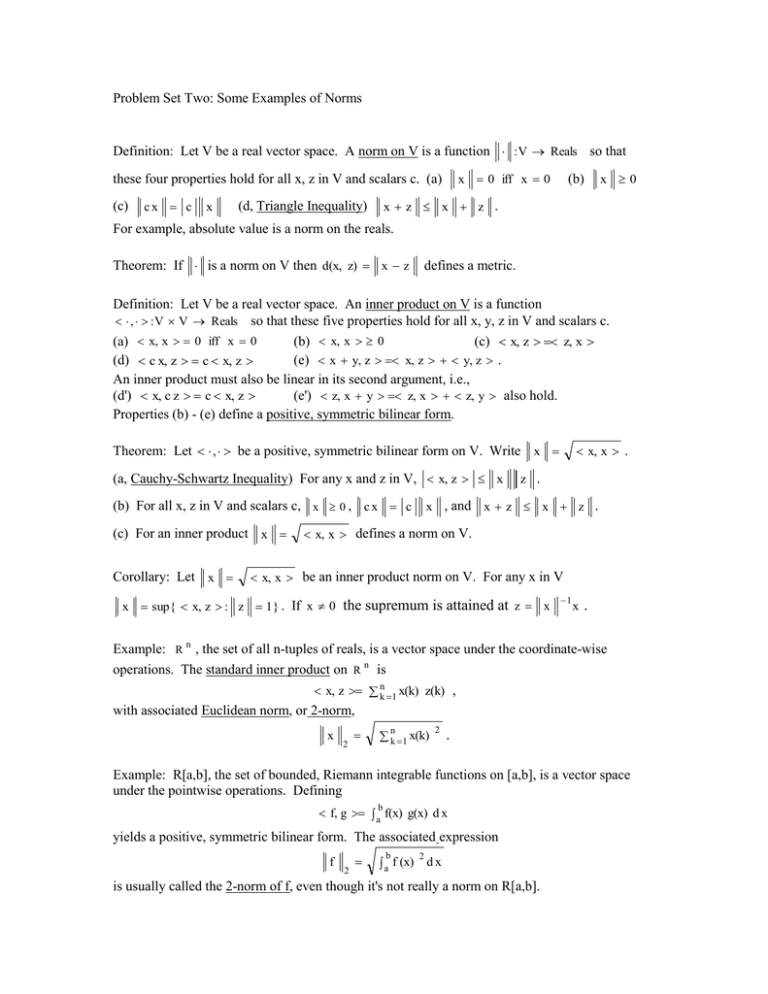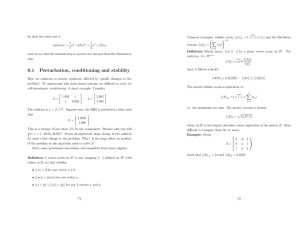Problem Set Two: Some Examples of Norms
advertisement

Problem Set Two: Some Examples of Norms
Definition: Let V be a real vector space. A norm on V is a function : V Reals so that
x 0 iff x 0
these four properties hold for all x, z in V and scalars c. (a)
(c)
cx c
x
(b)
x 0
xz x z .
(d, Triangle Inequality)
For example, absolute value is a norm on the reals.
Theorem: If is a norm on V then d(x, z) x z
defines a metric.
Definition: Let V be a real vector space. An inner product on V is a function
, : V V Reals so that these five properties hold for all x, y, z in V and scalars c.
(a) x, x 0 iff x 0
(b) x, x 0
(c) x, z z, x
(d) c x, z c x, z
(e) x y, z x, z y, z .
An inner product must also be linear in its second argument, i.e.,
(d') x, c z c x, z
(e') z, x y z, x z, y also hold.
Properties (b) - (e) define a positive, symmetric bilinear form.
Theorem: Let , be a positive, symmetric bilinear form on V. Write x
(a, Cauchy-Schwartz Inequality) For any x and z in V, x, z x
(b) For all x, z in V and scalars c, x 0 , c x c
(c) For an inner product x
Corollary: Let x
x , and
x, x .
z .
xz x z .
x, x defines a norm on V.
x, x be an inner product norm on V. For any x in V
x sup{ x, z : z 1 } . If x 0
the supremum is attained at z x
1
x
.
Example: R n , the set of all n-tuples of reals, is a vector space under the coordinate-wise
operations. The standard inner product on R n is
x, z nk 1 x(k) z(k) ,
with associated Euclidean norm, or 2-norm,
x
2
n
k 1 x(k)
2
.
Example: R[a,b], the set of bounded, Riemann integrable functions on [a,b], is a vector space
under the pointwise operations. Defining
b
f, g a f(x) g(x) d x
yields a positive, symmetric bilinear form. The associated expression
f
2
b
a f (x)
2
dx
is usually called the 2-norm of f, even though it's not really a norm on R[a,b].
b
Theorem: If f R [a, b] and a f (x) 2 d x 0 then f(z) = 0 at each point of continuity of f.
Corollary: C[a,b], the set of continuous real valued function on [a,b], is a vector space under the
pointwise operations. The 2-norm is a norm on C[a,b].
PROBLEMS
Problem 2-1: For x, y and z points in a metric space, d(x, z) d(y, z) d(x, y) .
For (S,d) a metric space and T a subset of S, the restriction of d to T T is clearly a metric on T,
called the inherited metric on T. The pair (T,d) is called a subspace of (S,d). For instance
{ 0 ,1}
N
is a subspace of [ 0 ,1 ] N . Another way to generate metric spaces is by taking products.
Problem 2-2: If (X,d) and ( Y , ) are metric spaces then setting
(d ρ) (x, y), (u, v) max { d(x, u), ρ(y, v) } defines a metric on the product X Y .
( X Y, d ρ ) is the product of the metric spaces (X,d) and ( Y , ) .
The next problems define two of the p-norms x
p
on R n . The metric space ( R n , x
p
)
is
denoted by l np . The 2-norm is the Euclidean norm.
Problem 2-3: For x ( x(1), x(2), ... , x(n) ) define x
(a)
x
max { x(1) , x(2) , ... , x(n) } .
is a norm on R n .
(b) The metric determined by this norm is called the box metric. To see why sketch the closed
balls CB(0,1) in R 2 and R 3 .
(c) l 2 is the product of two copies of R, each with the usual metric.
Problem 2-4: For x ( x(1), x(2), ... , x(n) ) define x
(a)
x
1
is a norm on R n .
1
n
k 1
x(k)
.
(b) Sketch the closed balls CB(0,1) in R 2 and R 3 .
(c) On the subset S { 0 , 1 } n the inherited metric is the Hamming Metric
H(x, y) card { k : x(k) y(k) }
Problem 2-5: (a, Parallelogram Law) In the 2-norm x y
2
xy
2
2
2 x
2 y
2
for any two vectors x and y in R n . (b) Show by example that the parallelogram law fails for
both x
and x
1
.
Problem 2-6: Fix an n-tuple x and consider the minimum of f(t) x (t, t, ... , t)
p
.
(a) For p = 2 the minimum occurs when t 0 n 1 nk 1 x(k) . What is n 1/2 f(t 0 ) called?
(b) For p = 1 the minimum occurs at each median of x(1), x(2), ... , x(n).
(c) Find the minimum and the point(s) at which it occurs in case p .
Problem 2-7: A set E in a vector space V is convex iff E contains the line segment between any
two points in E, equivalently, iff t x ( 1 t) y E for all x and y in E and scalars t [0,1] .
(a) If the metric is determined by a norm then all open and closed balls are convex.
(b) Give an example of a metric on a vector space and an open ball that is not convex.
OTHER p-NORMS
Lemma: Fix p > 1 and let q satisfy 1 / p 1 / q 1 (q is the conjugate of p). For a and b nonnegative, a b inf { (t a) p /p ( t 1 b) q /q : 0 t } .
Sketch Proof: Write f(t) (t a) p /p ( t 1 b) q /q. If a = 0 then inf f lim t ( t 1 b) q /q 0 and
similarly when b = 0. For positive a and b, f has a minimum when f (t) 0 . The derivative is
zero for t 0 b 1/p a 1/q and f(t 0 ) a b .
For p > 1 and x ( x(1), x(2), ... , x(n) ) in R n the p-norm of x is
x
p
n
k 1
p 1/p
x(k)
.
The sign of a real number t is sgn(t) = 1 if t 0 , and sgn(t) 1 otherwise.
Theorem: Fix p > 1 and let q satisfy 1 / p 1 / q 1 .
(a, Holder's Inequality) For x and z in R n , x, z x
(b) For each x in R n , x
p
sup{ x, z : z
p/q
the vector with coordinates z(k) x
z
p
q
.
1 } . If x 0 the supremum is attained at
q
sgn x(k)
p 1
x(k)
.
(c) The p-norm is a norm on R n . The p-norm’s triangle inequality is the Minkowski Inequality.
Sketch Proof: First use the lemma in each coordinate. For t > 0 and any k
x(k) z(k)
(1/p) t
p
x(k)
p
(1/q) t
q
z(k)
q
.
Summing the last inequalities,
x, z nk 1 x(k) z(k)
p
(1/p) t nk 1 x(k)
(1/p) t
p
x
p
p
(1/q) t
(1/q) t
q
z
q
n
k 1 z(k)
q
q
Using the lemma again to minimize the last expression establishes (a). Parts (b) and (c) follow by
arguing as with the 2-norm.





